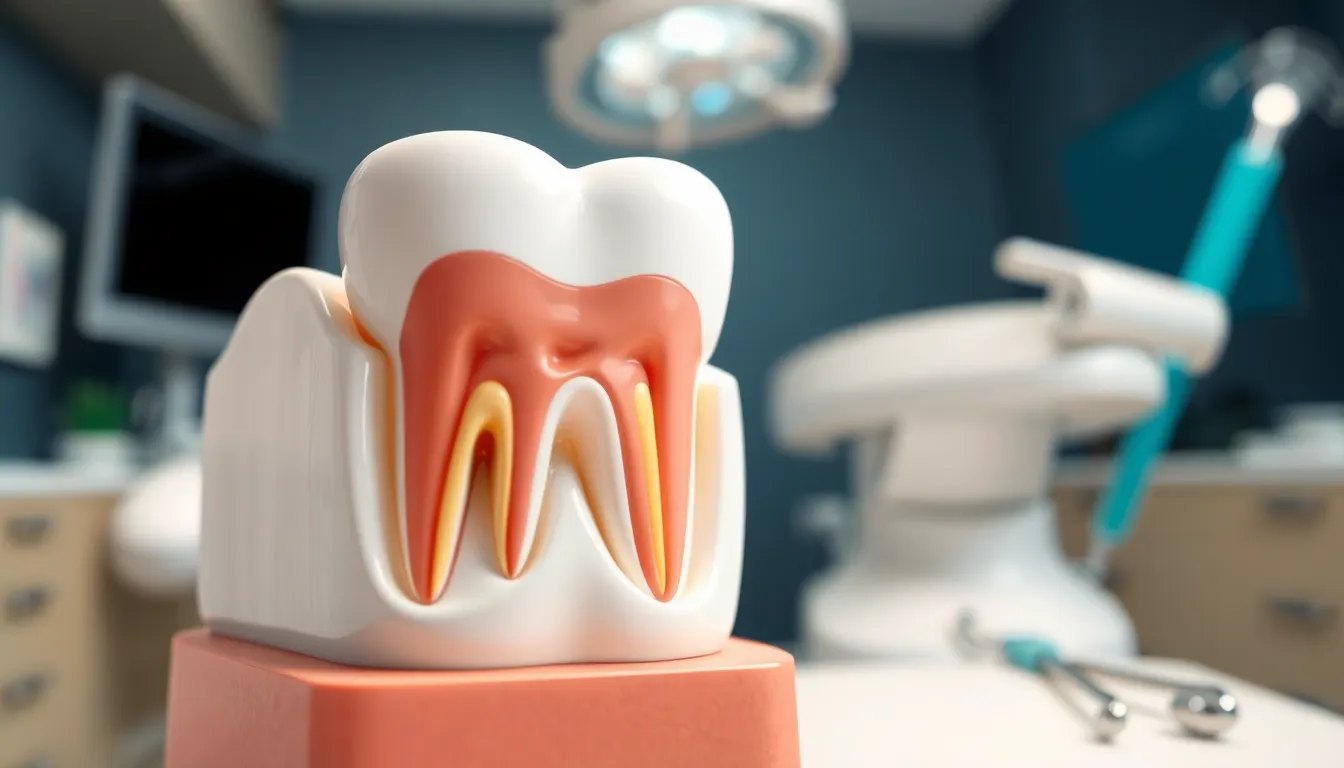Have you ever wondered how many root canals is too many? This common dental procedure might save your teeth, but there comes a point when alternative treatments could be better options.
When facing multiple root canals, it’s natural to question if there’s a limit. While there’s no exact number that’s “too many,” several factors determine when you should consider other answers. Your overall oral health, the condition of the affected teeth, and long-term dental goals all play crucial roles in this decision. Dentists typically evaluate each case individually, weighing the benefits of saving natural teeth against the potential success rate of repeated root canal treatments.
Understanding Root Canal Therapy
Root canal therapy is a common dental procedure designed to save severely infected or damaged teeth. This treatment removes infected pulp from inside the tooth, eliminating pain while preserving your natural tooth structure.
What Happens During a Root Canal Procedure
During a root canal procedure, your dentist creates a small access hole in the tooth crown to reach the infected pulp chamber. The infected or inflamed pulp tissue is carefully removed using specialized instruments that clean out the root canals and pulp chamber. After thorough cleaning, the canals are shaped, disinfected with antimicrobial answers, and sealed with a rubber-like material called gutta-percha. A temporary or permanent filling is placed to close the access hole, and in most cases, a crown is later added to protect the weakened tooth structure and restore full function.
Dr. Harris explains, “I’ve performed thousands of root canals over my career, and patients are often surprised by how comfortable the procedure can be. Modern techniques and anesthetics have transformed what was once feared into a relatively routine treatment.”
Why Multiple Root Canals Might Be Needed
Multiple root canals become necessary when several teeth develop infections or when a previously treated tooth requires retreatment. Common reasons include severe decay affecting multiple teeth, trauma impacting several teeth, or extensive dental work that irritates the pulp. Genetic predispositions can also make some patients more susceptible to pulp inflammation across multiple teeth. Also, failed initial treatments occasionally require retreatment due to missed canals, incomplete cleaning, or reinfection.
The Limitations of Root Canal Treatment

Root canal therapy has physical and practical constraints even though its effectiveness at saving teeth. While no exact limit exists to how many root canals you can have overall, several factors determine when multiple treatments become problematic.
Structural Concerns for Teeth with Multiple Root Canals
Multiple root canal procedures on the same tooth compromise its structural integrity over time. Each treatment removes more internal tissue and further weakens the tooth’s foundation, making it more brittle and susceptible to fracture. Teeth that have undergone root canal therapy lose their natural blood supply and nerve connections, which affects their resilience and strength. Protective crowns become essential after treatment to prevent fractures, yet even with proper restoration, repeatedly treated teeth face higher failure rates.
Dr. Harris recently treated a patient who had received three separate root canal procedures on the same molar over a decade. “Even though our best efforts to save the tooth, the structural integrity had been so compromised that extraction and an implant eventually provided a better long-term solution,” he explained. The tooth’s remaining structure couldn’t reliably support another restoration, demonstrating how multiple treatments on a single tooth eventually reach diminishing returns.
Financial Considerations
The financial impact of multiple root canal treatments adds up significantly over time. Each procedure involves specialized cleaning, filling, and typically requires a crown or other restoration to protect the treated tooth. Insurance plans often limit coverage for endodontic retreatment on the same tooth, leaving patients with higher out-of-pocket expenses for subsequent procedures.
Signs That Alternative Treatments May Be Better

Root canal therapy isn’t always the best solution for every dental situation. Certain indicators suggest that alternative treatments might offer better long-term outcomes for your oral health. Recognizing these signs early can save you time, money, and discomfort.
When Extraction Becomes the Preferred Option
Extraction becomes the preferred option when your tooth shows signs of severe compromise even though previous treatments. Teeth with extensive fractures extending below the gumline rarely respond well to root canal therapy. Persistent infections that don’t resolve after multiple treatments often indicate underlying issues that extraction can address more effectively. Your dentist might recommend removal if bone loss around the tooth has progressed significantly, making long-term preservation unlikely.
Dr. Harris recalls a patient who had undergone two root canals on a lower molar within five years: “Even though our best efforts to save the tooth, repeated infections developed. The patient experienced chronic pain and swelling. After reviewing her case thoroughly, we determined extraction followed by an implant would provide more predictable relief and function. Six months later, she reported complete resolution of symptoms and was thrilled with her decision.”
Implants vs. Multiple Root Canals
Dental implants offer distinct advantages over multiple root canal treatments in exact scenarios. Implants provide a success rate of 95% over ten years compared to retreated root canals, which drop to 75% success after the second attempt. They eliminate the risk of reinfection since the problematic tooth is completely removed and replaced with a titanium post that integrates with your jawbone.
Cost considerations often favor implants when analyzing long-term expenses. A single implant might cost more initially, but multiple root canals on the same tooth—plus the inevitable crown replacements—can exceed implant costs over time. Implants also maintain bone density in your jaw, preventing the sunken appearance that sometimes follows tooth loss.
Factors Dentists Consider When Recommending Multiple Root Canals

Dentists evaluate several key factors when determining if additional root canal treatments are appropriate for a patient. These considerations help create personalized treatment plans that balance tooth preservation with long-term oral health outcomes.
Tooth Location and Function
The anatomical complexity of different teeth directly impacts root canal treatment decisions. Front teeth typically contain only one canal, making them more straightforward to treat effectively. Molars, but, present greater challenges with their multiple canals—often having three or four distinct pathways that require treatment. Your back teeth bear most of your chewing force and feature more complex root structures that can hide additional canals or have unusual formations.
Dr. Harris recalls treating a patient whose lower molar required careful consideration: “I examined the radiographs closely because molars often have hidden canal branches. Missing even one canal would leave infection behind and cause the treatment to fail. The complexity of this tooth’s root system meant we needed to discuss the likelihood of success versus alternative options.”
Overall Oral Health Status
Your complete oral health picture significantly influences recommendations for multiple root canal treatments. The condition of your jawbone provides the foundation for successful outcomes, as compromised bone structure can limit treatment options. Patients with fewer remaining natural teeth may face different considerations when deciding between saving a compromised tooth or exploring alternatives.
“I recently consulted with a patient who had already undergone root canals on five different teeth,” shares Dr. Harris. “While there’s no exact limit to how many root canals a person can have, we needed to evaluate her overall dental health pattern. Her recurring infections indicated potential underlying issues that might affect future treatment success. We discussed how her thin jawbone in certain areas might impact long-term tooth stability even after successful root canal therapy.”
The number of available teeth also factors into treatment planning—success rates for initial root canal procedures range from 86-98%, but this drops significantly to 50-75% for retreatments on the same tooth. These statistics guide dentists in making recommendations that provide the best long-term value and function for patients facing decisions about multiple root canal treatments.
Long-Term Success Rates of Multiple Root Canals

Root canal success rates vary significantly between initial treatments and subsequent procedures on the same tooth. Understanding these statistics helps patients make informed decisions about pursuing multiple root canal treatments versus considering alternative options.
Statistical Outcomes for Retreated Teeth
First-time root canal treatments boast impressive success rates of 86% to 98%, making them highly reliable for saving infected teeth. But, these numbers drop considerably for retreatment cases, with success rates typically falling between 50% and 75%. Retreatments become necessary for various reasons, including incomplete canal cleaning during the initial procedure, missed accessory canals, new decay around old fillings, or failed crown restorations that allow bacteria to re-enter the tooth.
“I’ve seen patients who’ve undergone retreatment with excellent outcomes, but it’s important to have realistic expectations,” explains Dr. Todd B. Harris. “One patient came to me after having a root canal that failed after just two years. We discovered an additional canal that had been missed during the initial treatment. After retreating all canals properly, that tooth has remained healthy for over a decade now.”
Several factors influence retreatment success, including:
- The amount of remaining tooth structure
- Previous damage to the root during earlier procedures
- Presence of untreated infection in surrounding bone
- Quality of the restoration (crown) protecting the tooth
Lifetime Expectations for Root Canal Treated Teeth
Properly treated and restored root canal teeth can last 8 to 10 years or longer in about 90% of cases. Longevity depends heavily on post-treatment care and overall oral health maintenance. Teeth that receive recommended crowns after root canal therapy show significantly better survival rates than those left unprotected.
Your jawbone condition plays a crucial role in supporting root canal treated teeth long-term. Patients with healthy bone density typically experience better outcomes than those with compromised bone structure due to periodontal disease or other conditions.
Dr. Harris notes, “I’ve tracked patients with multiple root canals for years, and those who maintain excellent oral hygiene routines and attend regular check-ups often keep their treated teeth for decades. A memorable case involved a patient with four root canal treated molars who’s maintained all of them for over 20 years through diligent care and prompt attention to any new dental issues.”
The number of natural teeth remaining in your mouth also affects treatment decisions. Preserving strategic teeth through root canal therapy helps maintain proper bite function and prevents adjacent teeth from shifting, which can create additional problems down the line.
Regular dental monitoring becomes increasingly important as the number of root canal treated teeth increases. X-rays every 1-2 years help detect early signs of failure before symptoms develop, allowing for timely intervention that may extend the life of treated teeth.
Conclusion
The question of “how many root canals is too many” doesn’t have a one-size-fits-all answer. Your unique dental situation requires personalized evaluation rather than an arbitrary limit.
When deciding between additional root canals or alternative treatments like extraction and implants consider the tooth’s structural integrity remaining bone support and the likelihood of long-term success.
Trust your dentist to guide this decision-making process but don’t hesitate to seek a second opinion for complex cases. Remember that while preserving natural teeth is ideal sometimes an implant offers better long-term value and comfort.
Eventually your oral health goals financial considerations and quality of life should drive these important dental decisions.
Frequently Asked Questions
Is there a limit to how many root canals a person can have?
No, there isn’t a specific numerical limit to how many root canals one person can have. The decision depends on factors like overall oral health, condition of the affected teeth, and long-term dental goals. Each case is assessed individually by dentists who balance the benefits of preserving natural teeth against the likelihood of success for repeated procedures.
How successful are root canal retreatments?
Initial root canals have success rates between 86-98%, but retreatments are significantly lower at 50-75%. Success depends on remaining tooth structure, previous root damage, untreated infections, and restoration quality. The more compromised the tooth is from previous treatments, the lower the chances of long-term success with additional root canal therapy.
Why might someone need multiple root canals?
Multiple root canals may be necessary when several teeth develop infections simultaneously, when previously treated teeth require retreatment due to persistent infection, or because of genetic predispositions that increase susceptibility to pulp inflammation. Some people naturally have more dental issues requiring endodontic intervention throughout their lifetime.
How do dental implants compare to multiple root canals?
Dental implants typically have higher long-term success rates than teeth that have undergone multiple root canals. Implants eliminate the risk of reinfection, help maintain jawbone density, and can be more cost-effective over time despite higher initial costs. For severely compromised teeth, implants often provide a more predictable outcome.
What are signs that alternatives to root canal might be better?
Consider alternatives when teeth show severe structural compromise, persistent infections after multiple treatments, significant bone loss around the tooth, or when the cost of repeated treatments exceeds that of replacement options. If you’ve had multiple unsuccessful root canals on the same tooth, extraction followed by an implant might provide better long-term relief.
How long do root canal treated teeth typically last?
Properly treated root canal teeth last 8-10 years or longer in about 90% of cases. Longevity depends heavily on post-treatment care, including getting recommended crowns, maintaining good oral hygiene, and regular dental check-ups. Teeth that have undergone multiple root canals generally have shorter lifespans due to structural weakening.
Are front teeth easier to treat with root canals than back teeth?
Yes, front teeth are typically easier to treat because they usually have single, straight root canals. Molars have multiple canals with complex anatomy, making treatment more challenging and less predictable, especially for retreatments. The simpler structure of anterior teeth generally leads to higher success rates for endodontic procedures.
How often should root canal treated teeth be monitored?
Teeth that have undergone root canal treatment should be examined during regular dental check-ups (every 6 months). X-rays should be taken every 1-2 years to detect early signs of failure. More frequent monitoring may be recommended for teeth that have had multiple root canals or show signs of potential complications.







